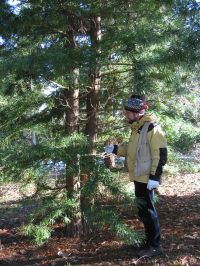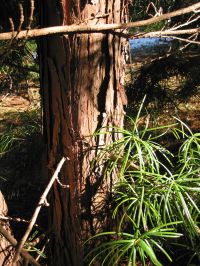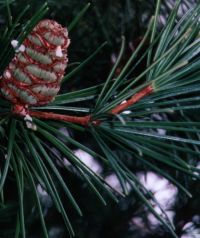Japanese umbrella pine - Sciadopitys verticillata
English name:
Japanese umbrella pine
Scientific name:
Sciadopitys verticillata
Family:
Sciadopitaceae (Umbrella pines)
Height:
10-15 M in Denmark
Flowering:
Spring
Range:
Japan central Honshu, Kyushu, Shikoku
 |
|
 |
 |
The 55 year old tree in the photograph can be found in the Arboretums East Asian conifer collection, in square 1213 position 832.
Plant description:
The genus Sciadopitys is unique and the single living species is the sole surviving member of the Umbrella-Pine family. The genus has a natural range in the mountains of Japan although it once was very widespread throughout the northern hemisphere. It has a long history extending back into the Jurassic. It survived for a long time in Europe and even is reported to have returned to Northwest Europe after the first two of the 6 most recent ice ages. But the third ice age was too much and it never returned, until re-imported as a garden plant from Japan. Our oldest specimen (about 12 m tall) was planted in 1890 in the Forest Botanic Garden and is probably the oldest in Denmark. This tree has produced many seeds but perhaps because of self fertilization, the growth of the progeny has been poor. We received seed in 1986 from two trees growing in Stensbygård, Denmark and growth of some plants has been 30 cm or more in height the past two years.
Sciadopitys verticillata can be recommended as a unique garden tree and the slow growth keeps it from outgrowing its place. The unique, elegant needles would give a nice background to other plants. However, it does not like basic soils and it is best in shelter from the wind. Perhaps this is why our plants seem to look best when grown in the company of larger surrounding trees. This species is reported to be quite resistant to honey fungus. One internet site (http://users.bestweb.net/~habitat/deer.htm) also recommends it for deer plagued gardens but one of our newest plantings was frayed and the top killed by our antlered friends.
The long soft needles occur in whorls along the twigs and thus are unlike any other plant. The English (and scientific) name refers to the way the needles occur in whorls much like the spokes on umbrellas. They have a deep furrow and internally two vascular bundles as if two needles have grown together. This has led to a debate as to whether they are two fused leaves or leaf-like shoots (phylloclads).
The female cones ripen in two years and are striking at one stage because the scales are green with brown edges. Although the English name Umbrella-pine seems to indicate they belong to the pine family they are quite different. One aspect are the 5 to 9 seed per seed scale whereas true pines only have two seeds per cone scale.
The Arboretums and Forest Botanic Gardens 18 living specimens range in age from 17 to about 113 years in age.
References:
Rushforth, K. 1999. Trees of Britain and Europe. Harper Collins Publisher. Pp 1131-1133
Mitchell, A. & Ødum S. 1983. Træer i Nordeuropa. Gads forlag, Copenhagen, pp. 90.
Florin, R. 1967. The distribution of conifer and taxad genera in time and space. Acta Horti Bergiani 20:216-219
